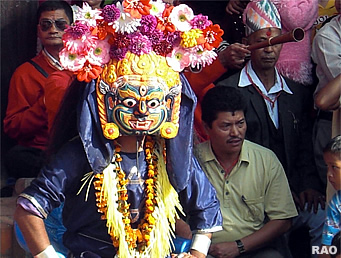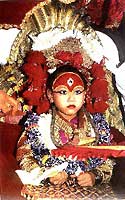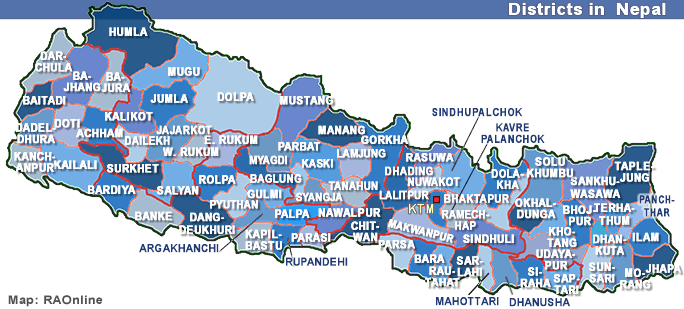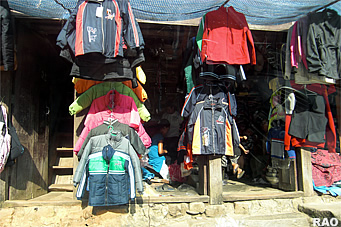|
Ecologically |
 |
 |
| The
country is divided into three regions: the high mountain region, with the
Himalayas peaking at 8,839 meters above sea level to the north; the midhill
region, with altitudes ranging between 610 and 4,877 meters in the Mahabharat
range and the Gangetic plains; and the Terai, ranging between 152 and 610
meters to the south.
This
topographical diversity is matched by climatic diversity, with climatic
conditions ranging between those of the extremely cold tundra to those
of the hot humid tropics. |
|
Currently
Nepal's population is estimated to be about 27.8 (2007, estimated) million. Over the 1981-1991 period, it grew by 2.2 percent annually, up
from 15 million in 1981 to 18.4 million by 1991. A major consequence of
this was increased population density.
| National
census 2001 estimations: Nepal's population reached 23.4 million coinciding
with the 10th National Census day. The kingdom's population was 18.4 million
10 years ago in 1991. The country's population is growing at an estimated
2.4 percent annually.
October,
2005: Nepal's population has reached 27.1 million, according to the
United Nations Population Fund (UNFPA.
In
1991, the average population density was 125.6 persons per square kilometer
(skm), with the heaviest population pressure in the Kathmandu Valley. While
this may not be as high as in many countries , it is important to note
that it increased from 56 persons per skim in 1952-1954 to 102 persons
per skim in 1981, and to 126 persons per skim in 1991.
|
 |
Moreover,
population pressure on cultivated land is much higher than these averages
suggest. The population density also varies from region to region.
The
Terai is the most densely populated, while the mountains are sparsely populated
The Terai population density has almost doubled in the last two decades
as a result of the north-south movement of the population and immigration.
In
terms of its composition, the population is becoming younger.
The
proportion of the population under 15 years of age has been increasing
in the past 20 years, with boys under 15 increasing from 40.9 percent of
the male population to 43.5 percent, and girls under 15 from 40 percent
of the female population to 41.3 percent. At the other end of the age curve,
the 1991 census reveals that 5.9 percent of the total population was 60
years of age and above, compared with 5.7 percent of the female population
.
Accordingly,
the age-specific sex ratios have also been changing. In addition, the sex
composition of the population is changing in favour of women.
top
| Human
Development Indicators |
 |
Nepal
has made much progress in building social infrastructure and has achieved
much in terms of human development. For example, health facilities at the
grassroots level have expanded rapidly; universal immunization against
smallpox, diphtheria, pertussis, tetanus, etc. has been achieved; and the
overall literacy rate increased threefold between 1971 and 1996. Nevertheless,
over half of the population is still illiterate and, according to the Human
Development Report ( 1998), Nepal's human development index (HDI) ranking
is just above that of Bhutan, which has the lowest HDI ranking in the region.
Moreover,
the health and sanitation situation in the country remains poor. Only 9.2
percent of households have access to modern sanitation facilities (sewerage
and waste disposal), and 21.6 percent to toilets .
The
problem is even more acute in rural areas where only 5.8 percent of households
have access to sanitary systems. Access to protected drinking water-including
piped and covered water sources is 96 percent in urban areas and 68 percent
in rural areas, but the quality of even the piped water is questionable,
as indicated by the poor water quality in Kathmandu. Only about one quarter
of households were collecting water from fully protected supply sources,
one half from partially protected sources and one quarter from unprotected
sources.
Malnutrition
among children is widespread. In 1996 a survey found stunting among
64 percent of children. A large proportion of children have problems of
Vitamin A deficiency. The major cause is the problem in feeding patterns
combined by infection, diarrhoea, and lack of access to clean water and
sanitation.
Infant
mortality rate (IMR), although declining over the years, is still one of
the highest in the region. The most recent report puts overall IMR
at 78.5 per 1000 live births, 61.1 for urban areas and 95.3 for rural areas.
Under-five mortality rate also shows a declining trend, but remains at
the fairly high level of 125 per 1.000 children under five. The crude death
rate for the population as a whole has also declined substantially during
the last three decades. This is reflected in increasing life expectancy
rates.
 |
top
| Cultural
Setting |
 |
Nepal's
cultural landscape is extremely diverse and is composed of more than 50
known language groups and subgroups. These groups can be divided largely
into two groups on the basis of the languages they speak, i.e., Indo-Aryan
and Tibeto-Burman. As far as the social relations governing the status
of women are concerned, however, there is a large variation within each
of these groups.
 |
| The
politically and culturally predominant Indo-Aryan ethnic group lives mostly
in the hills and the Tersi. In terms of attitudes towards women, the Maithili
and the Abadhi are the most conservative communities of the Indo-Aryan
group, with the mobility of women outside the household being highly restricted
in Maithili and other Terai communities. Women wear purdah (veil) and they
may not mix freely with the opposite sex. Although other subgroups within
the Indo-Aryan culture do not all practice strict purdah, where it is practised,
it is considered proper for women to restrict their activities to the household.
Sexual
purity of women is extremely important for the lndo-Aryan group. Child
marriage, a restriction on widows remarrying and arranged marriages are
still followed widely. Property is inherited only through the male line
and therefore, women's economic status both in the household and in the
community is lower than that of men. |
|
Similarly,
due to restrictions on their mobility, women's access to education and
training-and, consequently, modern avenues of income-are limited.
 |
| The
Tibeto-Burman group mostly live in the hills and the mountains. Women from
these groups are free to engage in various income-generating activities
or businesses outside the household, and they are respected for undertaking
such activities. They travel widely for trading and business, and operate
lodges and teahouses along the trekking routes and major roads and in tourist
areas. Women have relative freedom in their choice of marriage partners,
and premarital sexual relations and social mixing occur. Child marriages
are rarer than with their counterparts in the Indo-Aryan group. |
|
In
spite of this cultural diversity, land is universally inherited in all
communities from father to son, with women lagging far behind men in terms
of access to knowledge, economic resources, and modern avenues of employment.
top
| The
Economy |
 |
The
Nepalese economy is still predominantly agricultural, with 86 percent of
the population living in rural areas and 81 percent deriving their livelihoods
from agriculture. Agricultural productivity is low: US$114 value added
per worker per annum. An estimated 4-50 percent of the population do not
have adequate income to meet their basic minimum needs of food, clothing,
shelter, primary education, and health care.
Nepal
has a virtually open border with India, and it maintains two separate exchange
rate regimes: one with India and another with overseas countries. Its major
exports to overseas countries comprise carpets and garments, both of which
have faced international market problems in recent years; while its exports
to India consist mostly of primary products. The country's manufacturing
sector is small and at an early stage of development, and its demand for
developmental goods and industrial hat be met entirely from imports. Its
tourism industry, while contributing substantially to the economy, is still
underexploited in terms of its potential.
top
|
more
information |
 |
|









